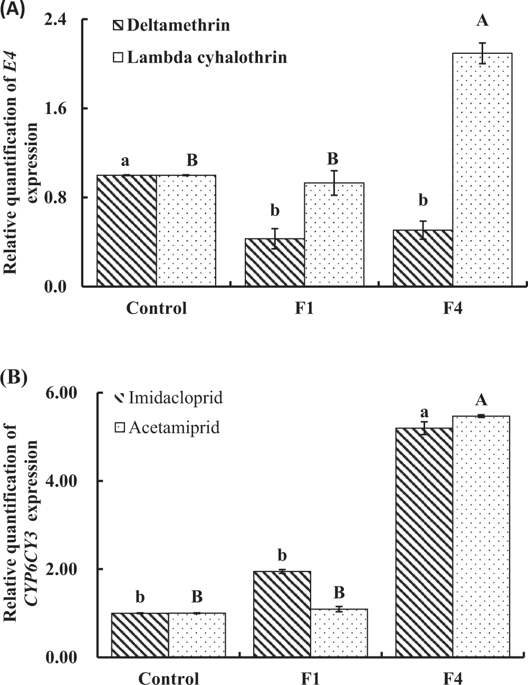Our official English website, www.x-mol.net, welcomes your
feedback! (Note: you will need to create a separate account there.)
Evaluation of Insecticides induced hormesis on the demographic parameters of Myzus persicae and expression changes of metabolic resistance detoxification genes.
Scientific Reports ( IF 3.8 ) Pub Date : 2018-11-09 , DOI: 10.1038/s41598-018-35076-1 Muhammad Umair Sial 1 , Zhenzhen Zhao 1 , Lan Zhang 1 , Yanning Zhang 1 , Liangang Mao 1 , Hongyun Jiang 1
Scientific Reports ( IF 3.8 ) Pub Date : 2018-11-09 , DOI: 10.1038/s41598-018-35076-1 Muhammad Umair Sial 1 , Zhenzhen Zhao 1 , Lan Zhang 1 , Yanning Zhang 1 , Liangang Mao 1 , Hongyun Jiang 1
Affiliation

|
Insecticide induced-hormesis is a bi-phasic phenomenon generally characterized by low-dose induction and high-dose inhibition. It has been linked to insect pest outbreaks and insecticide resistance, which have importance in the integrated pest management (IPM). In this paper, hormesis effects of four insecticides on demographic parameters and expression of genes associated with metabolic resistance were evaluated in a field collected population of the green peach aphid, Myzus persicae Sulzer. The bioassay results showed that imidacloprid was more toxic than acetamiprid, deltamethrin and lambda-cyhalothrin. After exposure to sublethal doses of acetamiprid and imidacloprid for four generations, significant prolonged nymphal duration and increased fecundity were observed. Subsequently, mean generation time (T) and gross reproductive rate (GRR) was significantly increased. Moreover, expression of CYP6CY3 gene associated with resistance to neonicotinoids was increased significantly compared to the control. For pyrethriods, across generation exposure to sublethal doses of lambda cyhalothrin and deltamethrin prolonged the immature development duration. However, the expression of E4 gene in M. persicase was decreased by deltamethrin exposure but increased by lambda cyhalothrin. Based on results, demographic fitness parameters were effected by hormetic dose and accompanied with detoxifying genes alteration, hence, which would be evaluated in developing optimized insect pest management strategies.
中文翻译:

评价杀虫剂对桃蚜的人口统计参数和代谢抗性解毒基因表达变化的兴奋作用。
杀虫剂引起的兴奋是一种双相现象,通常以低剂量诱导和高剂量抑制为特征。它与害虫的爆发和对杀虫剂的抗性有关,这在害虫综合治理(IPM)中具有重要意义。在本文中,在田间采集的桃蚜(Myzus persicae Sulzer)田间种群中评估了四种杀虫剂对人口参数的兴奋作用和与代谢抗性相关的基因的表达。生物测定结果表明吡虫啉比乙酰胺,溴氰菊酯和λ-氟氯氰菊酯具有更高的毒性。暴露于亚致死剂量的乙酰胺和吡虫啉四代后,发现显着延长的若虫持续时间和繁殖力增加。随后,平均世代时间(T)和总生殖率(GRR)显着增加。而且,与对照相比,与对新烟碱类的抗性有关的CYP6CY3基因的表达显着增加。对于拟除虫菊酯而言,全世代暴露于亚致死剂量的lamcyda cyhalothrin和溴氰菊酯会延长未成熟的发育持续时间。然而,溴氰菊酯暴露降低了百日咳粘膜梭菌中E4基因的表达,而氯氟氰菊酯却增加了E4基因的表达。根据结果,人口适应性参数受制止剂量的影响,并伴随有排毒基因的改变,因此,将在制定优化的害虫管理策略时对其进行评估。与对照组相比,CYP6CY3基因的表达与新烟碱类药物的耐药性显着增加。对于拟除虫菊酯而言,全世代暴露于亚致死剂量的lamcyda cyhalothrin和溴氰菊酯会延长未成熟的发育持续时间。然而,溴氰菊酯暴露降低了百日咳粘膜梭菌中E4基因的表达,而氯氟氰菊酯却增加了E4基因的表达。根据结果,人口适应性参数受制止剂量的影响,并伴随有解毒基因的改变,因此,将在制定优化的害虫治理策略时对其进行评估。与对照组相比,CYP6CY3基因的表达与新烟碱类药物的耐药性显着增加。对于拟除虫菊酯而言,全世代暴露于亚致死剂量的lamcyda cyhalothrin和溴氰菊酯会延长未成熟的发育持续时间。然而,溴氰菊酯暴露降低了百日咳粘膜梭菌中E4基因的表达,而氯氟氰菊酯却增加了E4基因的表达。根据结果,人口适应性参数受制止剂量的影响,并伴随有排毒基因的改变,因此,将在制定优化的害虫管理策略时对其进行评估。溴氰菊酯的暴露会降低百事可乐的摄入量,而氟氯氰菊酯则可以增加百事可乐的抵抗力。根据结果,人口适应性参数受制止剂量的影响,并伴随有排毒基因的改变,因此,将在制定优化的害虫管理策略时对其进行评估。溴氰菊酯的暴露会降低百事可乐的摄入量,而氟氯氰菊酯则可以增加百事可乐的抵抗力。根据结果,人口适应性参数受制止剂量的影响,并伴随有排毒基因的改变,因此,将在制定优化的害虫管理策略时对其进行评估。
更新日期:2018-11-09
中文翻译:

评价杀虫剂对桃蚜的人口统计参数和代谢抗性解毒基因表达变化的兴奋作用。
杀虫剂引起的兴奋是一种双相现象,通常以低剂量诱导和高剂量抑制为特征。它与害虫的爆发和对杀虫剂的抗性有关,这在害虫综合治理(IPM)中具有重要意义。在本文中,在田间采集的桃蚜(Myzus persicae Sulzer)田间种群中评估了四种杀虫剂对人口参数的兴奋作用和与代谢抗性相关的基因的表达。生物测定结果表明吡虫啉比乙酰胺,溴氰菊酯和λ-氟氯氰菊酯具有更高的毒性。暴露于亚致死剂量的乙酰胺和吡虫啉四代后,发现显着延长的若虫持续时间和繁殖力增加。随后,平均世代时间(T)和总生殖率(GRR)显着增加。而且,与对照相比,与对新烟碱类的抗性有关的CYP6CY3基因的表达显着增加。对于拟除虫菊酯而言,全世代暴露于亚致死剂量的lamcyda cyhalothrin和溴氰菊酯会延长未成熟的发育持续时间。然而,溴氰菊酯暴露降低了百日咳粘膜梭菌中E4基因的表达,而氯氟氰菊酯却增加了E4基因的表达。根据结果,人口适应性参数受制止剂量的影响,并伴随有排毒基因的改变,因此,将在制定优化的害虫管理策略时对其进行评估。与对照组相比,CYP6CY3基因的表达与新烟碱类药物的耐药性显着增加。对于拟除虫菊酯而言,全世代暴露于亚致死剂量的lamcyda cyhalothrin和溴氰菊酯会延长未成熟的发育持续时间。然而,溴氰菊酯暴露降低了百日咳粘膜梭菌中E4基因的表达,而氯氟氰菊酯却增加了E4基因的表达。根据结果,人口适应性参数受制止剂量的影响,并伴随有解毒基因的改变,因此,将在制定优化的害虫治理策略时对其进行评估。与对照组相比,CYP6CY3基因的表达与新烟碱类药物的耐药性显着增加。对于拟除虫菊酯而言,全世代暴露于亚致死剂量的lamcyda cyhalothrin和溴氰菊酯会延长未成熟的发育持续时间。然而,溴氰菊酯暴露降低了百日咳粘膜梭菌中E4基因的表达,而氯氟氰菊酯却增加了E4基因的表达。根据结果,人口适应性参数受制止剂量的影响,并伴随有排毒基因的改变,因此,将在制定优化的害虫管理策略时对其进行评估。溴氰菊酯的暴露会降低百事可乐的摄入量,而氟氯氰菊酯则可以增加百事可乐的抵抗力。根据结果,人口适应性参数受制止剂量的影响,并伴随有排毒基因的改变,因此,将在制定优化的害虫管理策略时对其进行评估。溴氰菊酯的暴露会降低百事可乐的摄入量,而氟氯氰菊酯则可以增加百事可乐的抵抗力。根据结果,人口适应性参数受制止剂量的影响,并伴随有排毒基因的改变,因此,将在制定优化的害虫管理策略时对其进行评估。















































 京公网安备 11010802027423号
京公网安备 11010802027423号